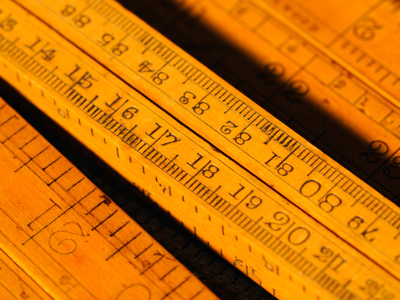
Ask the AI Tutor
Need help with Level 5-6 Numbers - Decimals - Multiplication and Division? Ask our AI Tutor!
AI Tutor - Lucy
Connecting with Tutor...
Please wait while we establish connection

There are 10 millimetres in a centimetre.
Level 5-6 Numbers - Decimals - Multiplication and Division
Learn how to multiply and divide decimals in KS3 Maths. Understanding decimals helps you work accurately with money, measurements, and real-life data.
1 .
What is 2.42 x 5?
10.2
11.7
12.1
13.5
To multiply by 5 simply move all the digits one place to the left and then halve the answer
2 .
What is 6.04 ÷ 4?
1
1.4
1.5
1.51
6 ÷ 4 =1.5 and 0.4 ÷ 4 = 0.01. Now just add these two figures together
3 .
What is 1,270.5 ÷ 15?
82.7
84.7
86.7
88.7
You could work this one out in your head by first dividing 1,270.5 by 3 to get 423.5. Next you would divide 423.5 by 10 to get 42.35 (one 30th of 1,270.5). Multiply this number by 2 for the answer: 84.7. Or you could use pen and paper - much easier!
4 .
How would you write 655.35mm in centimetres?
65.535cm
655.35cm
6,553.5cm
6,600cm
To divide by 10 just move all the digits one space to the right
5 .
There are 10 millimetres in a centimetre. How would you write 34.12cm in millimetres?
3.412mm
34.12mm
341.2mm
3,412mm
Remember - all the digits move one place to the left when multiplying by 10
6 .
What is 48.44 x 7?
339.08
340.44
484.47
500
An approximation would be 50 x 7 = 350 so you know straightaway that last two answers are wrong
7 .
Joseph spends a total of £34.44 on four new rose bushes for his garden. How much is one rose bush?
£3.40
£3.44
£8.44
£8.61
34 ÷ 4 = 8.5 and 0.44 ÷ 4 = 0.11. Add these two figures together for the answer
8 .
If a tube of toothpaste costs £1.57, how much do three tubes cost?
£3.15
£4.50
£4.66
£4.71
To double-check your answer, £1.57 + £1.57 + £1.57 is the same as £1.57 x 3!
9 .
Joanne is building a bookcase and needs 38 fixings at 14p each. How much in total will she pay for the fixings?
£3.40
£5.32
£53.20
£532.00
Remember that 14p = 0.14 when written in decimals!
10 .
A t-shirt costs £5.99. Mrs. Crawford bought one each for her four children. How much did she spend?
£20.00
£22.96
£23.96
£24.50
Remember to estimate the answer. £6.00 x 4 = £24.00, so the figure should be close to this
**Unlimited Quizzes Await You! 🚀**
Hey there, quiz champ! 🌟 You've already tackled today's free questions.
Ready for more?
Ready for more?
🔓 Unlock UNLIMITED Quizzes and challenge yourself every day. But that's
not all...
not all...
🔥 As a Subscriber you can join our thrilling "Daily Streak" against other
quizzers. Try to win a coveted spot on our Hall of Fame Page.
quizzers. Try to win a coveted spot on our Hall of Fame Page.
Don't miss out! Join us now and keep the fun rolling. 🎉
**Unlimited Quizzes Await You! 🚀**
Hey there, quiz champ! 🌟 You've already tackled today's free questions. Ready for more?
🔓 Unlock UNLIMITED Quizzes and challenge yourself every day. But that's not all...
🔥 As a Subscriber you can join our thrilling "Daily Streak" against other quizzers. Try to win a coveted spot on our Hall of Fame Page.
Don't miss out! Join us now and keep the fun rolling. 🎉






